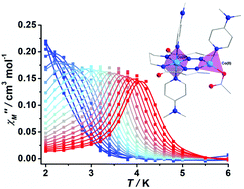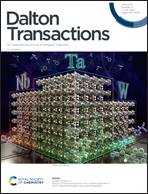Slow magnetic relaxation in dinuclear Co(iii)–Co(ii) complexes containing a five-coordinated Co(ii) centre with easy-axis anisotropy†
Abstract
Two air-stable Co(III)–Co(II) mixed-valence complexes of molecular formulas [CoIICoIII(L)(DMAP)3(CH3COO)]·H2O·CH3OH (1) and [CoIICoIII(L)(4-Pyrrol)3 (CH3COO)]·0.5CH2Cl2 (2) (H4L = 1,3-bis-(5-methyl pyrazole-3-carboxamide) propane; DMAP = 4-dimethylaminopyridine; and 4-Pyrrol = 4-pyrrolidinopyridine) were synthesized and characterized by single-crystal X-ray crystallography, high-field electron paramagnetic resonance (HFEPR) spectroscopy, and magnetic measurements. Both complexes possess one five-coordinated paramagnetic Co(II) ion and one six-coordinated Co(III) ion with octahedral geometry. Direct-current magnetic susceptibility and magnetization measurements show the easy-axis magnetic anisotropy that is also confirmed by low-temperature HFEPR measurements and theoretical calculations. Frequency- and temperature-dependent alternating-current magnetic susceptibility measurements reveal their field-assisted slow magnetic relaxation, which is a characteristic behavior of single-molecule magnets (SMMs), caused by the individual Co(II) ion. The effective energy barrier of complex 1 (49.2 cm−1) is significantly higher than those of the other dinuclear Co(III)–Co(II) SMMs. This work hence presents the first instance of the dinuclear Co(III)–Co(II) single-molecule magnets with a five-coordinated environment around the Co(II) ion.



 Please wait while we load your content...
Please wait while we load your content...